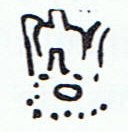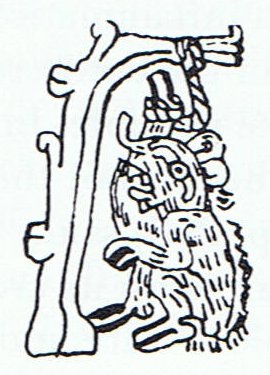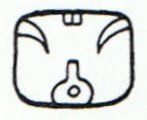|
TRANSLATIONS
What is the armadillo doing down there among the fishes? Is it a representation of the 'hare' in the moon? New questions arise and old ones evaporate.   The constellation with five otters busy stealing fish from a barbecue (Columba), placed there by a fisherman armed with a net stretched between Rigel, Betelgeuze and the three stars in the Belt of Orion have aquired more flesh. Of course it alludes to the fire lit on the turtle at the beginning of a new year, and of course the five otters are the five intercalendary dark days between the old and new year. The net in question maybe is illustrated on the shell of the turtle:  Of course we could evade the armadillo and just continue on our path, but that would probably make the journey take longer time. Short cuts are time consuming, winding paths lead quickly forward. There is another armadillo picture to consider:  The beast is inside a structure which ought to be the same kind of structure as that we which can see in the glyph above. The glyph accompanying the new picture is, though, radically different:  7 indicates the moon, I think. The long 'ears' seen on the surface of the moon seem to protrude upwards. The 'armadillo' is, however, not an armadillo, it is a composite beast (like the Tzec and the Mars beasts). The 'proof' comes by way of the same glyph type being used when the picture shows a 'peccary':   It is the Mars beast which is the 'peccary' alias the 'armadillo'. The same glyph type, but with 12 dots around the central 'fire'. The 'armadillo' glyph has, I guess, 13 dots instead. The 'armadillo' once again alludes to the moon (13 * 28 = 364), while the 'peccary' (Mars beast) suggests the sun (12 * 30 = 360). The glyph type ought to mean the cycle of the year. The Mars beast ('peccary') is hanging down from what may be the 'constellation band' across the waist of the sky. "Regarding the animal represented as a peccary, he [Knozorov] originally read '7 citam' (Knozorov 1955b, p. 53, no. 9), but later adopted the reading ken. Because of a superficial similarity of the glyph to the macaw glyger and the presence of number seven, associated with the macaw in the Popol Vuh, Seler (1902-1903, IV, 557-558) thought this was a macaw glyger. It occurs twice in the Dresden, once among the Venus gods and once as the name of a deity associated sexually with the White Goddess (D19b). Contextual evidence for identity is lacking in both cases. The full glyger, with '7', is found twice in Madrid, and the glyph without the '7' element appears once. In the latter case (M93a), a clear-cut peccary is shown [the Mars beast picture above] , caught in a trap, and the associated glyphs include only the 'trap' glyph and the glyph under discussion. In another passage dealing with trapping (M91a), the glyph of the figure shown is always in the third compartment. Here we have the full glyger. The animal shown [see below] seems to have hooves, a peccary snout, and an armadillo's ears and body ... A generic word which might apply equally well to peccary, armadillo, and deer would be welcome, but if it is necessary to choose between them, I would, like Knozorov, pick 'peccary'."   Now the winding armadillo path has led us back to Tzec: ... Two signs, Tzec and Pax, require the flaring open top, to distinguish them respectively from the chuen and the tun normal sign, on which they are formed." (Gates)
Comparing the chuen glyph with the 'peccary' glyph we can see the similarities - the 'peccary' glyph is the reverse of chuen. The 'urn' with, presumably, a sun symbol inside (at bottom center in the chuen glyph - indicating the sun, chu, and month, uen, measure) - or, more probable, the sun 'nut' from which the 'tree of sun light' has begun to grow upwards - has a dotted 'cycle' cirumference in the 'peccary' glyph. But the 'tree' is not dotted. Possibly the dots indicate the subdivisions of the sun cycle. In chuen the 'fangs' of the moon are inside, in the 'peccary' glyphs they are absent. Instead three 'henua' signs (possibly indicating surfaces illuminated by sun) are outside at the top. Inversely, two short 'henua' signs are inside at the top of chuen glyphs. I imagine chuen glyphs, with both 'sun tree', 'sun teeth', and 'moon fangs' inside could be interpreted as 'catching' both the moon and sun phenomena in a 'nutshell'. If so, then the 'peccary' glyphs 'belong to the night'. "The month of twenty days, known to the Yucatec Maya and modern students as the uinal, is designated by the same glyph as the day called Chuen in Yucatec and Batz in other Maya languages. The true phonetic rendering is still unknown, or at least has not been established to the satisfaction of most scholars studying the glyphs." Pax is at the opposite side of the year, also with a 'flaring top', and also with a measurment glyph connected:
"The period of 360 days was known in Yucatec by two terms, tun and haab, the latter being widely spread in the various Maya languages as a term for 'year'. The first glyph for the 360-day period (T548) was read as tun by Seler and may represent a drum."  "The tun glyph was identified as a wooden drum by Brinton (1895, p. 92), and Marshal H. Saville immediately accepted it. Figure 49 [excerpt above] shows the Aztec drum representation relied on by Brinton to demonstrate his point. It was not then known that an ancestral Mayan word for drum was *tun: Yucatec tunkul 'divine drum' (?); Quiche tun 'hollow log drum'; Chorti tun 'hollow log drum' (Wisdom 1940, pp. 175-176). The glyph is nearly the same as that for the month Pax (T549), except that the top part of the latter is split or divided by two curving lines. Brinton, without referring to the Pax glyph, identified the tun glyph as the drum called in Yucatec pax che (pax 'musical instrument'; che < *te 'wooden). Yucatec pax means 'broken, disappeared', and Quiche paxih means, among other things, 'split, divide, break, separate'. It would seem that the dividing lines on the Pax glyph may have been used as a semantic/phonetic determinative indicating that the drum should be read pax, not tun (cf. de Gruyter 1946, p. 27). Thus, one may expect that this glyph was used elsewhere meaning 'to break' and possibly for 'medicine' (Yuc. pax, Tzel., Tzo. pox)." |



